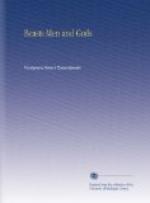I put up with a Russian firm and was at once visited by my associates from Uliassutai, who greeted me with great joy because they had been much exercised about the events in Van Kure and Zain Shabi. When I had bathed and spruced up, I went out with them on the street. We entered the bazaar. The whole market was crowded. To the lively colored groups of men buying, selling and shouting their wares, the bright streamers of Chinese cloth, the strings of pearls, the earrings and bracelets gave an air of endless festivity; while on another side buyers were feeling of live sheep to see whether they were fat or not, the butcher was cutting great pieces of mutton from the hanging carcasses and everywhere these sons of the plain were joking and jesting. The Mongolian women in their huge coiffures and heavy silver caps like saucers on their heads were admiring the variegated silk ribbons and long chains of coral beads; an imposing big Mongol attentively examined a small herd of splendid horses and bargained with the Mongol zahachine or owner of the horses; a skinny, quick, black Tibetan, who had come to Urga to pray to the Living Buddha or, maybe, with a secret message from the other “God” in Lhasa, squatted and bargained for an image of the Lotus Buddha carved in agate; in another corner a big crowd of Mongols and Buriats had collected and surrounded a Chinese merchant selling finely painted snuff-bottles of glass, crystal, porcelain, amethyst, jade, agate and nephrite, for one of which made of a greenish milky nephrite with regular brown veins running through it and carved with a dragon winding itself around a bevy of young damsels the merchant was demanding of his Mongol inquirers ten young oxen; and everywhere Buriats in their long red coats and small red caps embroidered with gold helped the Tartars in black overcoats and black velvet caps on the back of their heads to weave the pattern of this Oriental human tapestry. Lamas formed the common background for it all, as they wandered about in their yellow and red robes, with capes picturesquely thrown over their shoulders and caps of many forms, some like yellow mushrooms, others like the red Phrygian bonnets or old Greek helmets in red. They mingled with the crowd, chatting serenely and counting their rosaries, telling fortunes for those who would hear but chiefly searching out the rich Mongols whom they could cure or exploit by fortune telling, predictions or other mysteries of a city of 60,000 Lamas. Simultaneously religious and political espionage was being carried out. Just at this time many Mongols were arriving from Inner Mongolia and they were continuously surrounded by an invisible but numerous network of watching Lamas. Over the buildings around floated the Russian, Chinese and Mongolian national flags with a single one of the Stars and Stripes above a small shop in the market; while over the nearby tents and yurtas streamed the ribbons, the squares, the circles and triangles of the princes and private persons afflicted or dying




